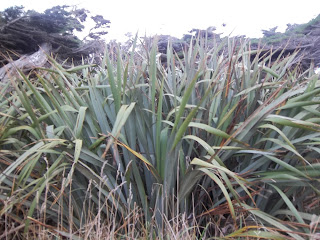We discovered a beautiful garden, at Kapuka, about 10 kms from Invercargill. This is a garden, tucked away on a side road, and not well sign posted. A real gem.
An old lignite pit, deserted, was bought by Dave and Maria Sanderson in about 2003, and transformed into a peaceful lakeside garden park. They allowed the pit to fill with water, ensured that there were two islands, and some large fir trees left, and then set about carving the surroundings into a garden. No plans were used during the building of the garden. But they did use a great amount of vision and creativeness, plus much hard work.
For those people who do not know what lignite is, it is a very substandard form of coal. The best coal, hard black coal, comes from deep underground, and lignite is a third grade form of coal, and it lies just under the surface. Lignite looks more like charcoal, and is petrified wood, which has been lying in a peaty soil. Lignite is used in open fires, and needs plenty of wood, and maybe a shovelful of hard coal with it, in order to burn well. Lignite also burns into a great amount of ash, which blows out into the room if disturbed. But it was a cheap form of fuel, and used by most Southlanders. Naturally people prefer other methods of keeping warm now. A small area of lignite has been left on the banks of the islands, so that people can look at it, and be thankful that they have lovely central heating or heat pumps.I loved the artistic screens that camouflaged the toilet.
The native black swans with their fluffy cygnets clustered around them, plus the ducks, were all looking for bread. Obviously well fed by the owners.
The garden also has two small museums, which hold cars, farm machinery, and household goods which Dave has collected over the years. Sorry no photographs, as I was so interested in the items being shown in the museum, as well as Dave's talk about them, that I forgot to take photographs. They also have a cafe, and small shop, a covered garden area, and a lavender walk. Such a delightful place to visit.On the note of gardens, I thought it important to include a photograph of flax bushes, which abound everywhere down here. They border the sides of roads, are used as shelter for farm animals, and of course grow in the native bush, because after all they are native New Zealand plants. Flax, is not a plant that I took much notice of until recently, but now I greatly admire it, not just for the usefulness (shelter, rope making etc) but as a plant that makes a statement, with its long stiff leaves, and many shades of green.
A chrysanthemum competition! Good enough for Chelsea.






No comments:
Post a Comment